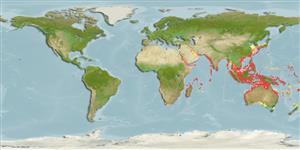Preferred temperature (Ref.
123201): 22.8 - 29, mean 28 °C (based on 1324 cells).
Phylogenetic diversity index (Ref.
82804): PD
50 = 0.5000 [Uniqueness, from 0.5 = low to 2.0 = high].
Bayesian length-weight: a=0.00661 (0.00586 - 0.00745), b=3.00 (2.97 - 3.03), in cm total length, based on LWR estimates for this species (Ref.
93245).
Trophic level (Ref.
69278): 4.5 ±0.4 se; based on diet studies.
Generation time: 3.6 (2.2 - 5.2) years. Estimated as median ln(3)/K based on 32
growth studies.
Widerstandsfähigkeit (Ref.
120179): mittel, Verdopplung der Population dauert 1,4 - 4,4 Jahre. (K=0.12-0.21; tm=2-3; tmax=14; Fec=590,000).
Prior r = 0.98, 95% CL = 0.65 - 1.47, Based on 1 full stock assessment.
Fishing Vulnerability (Ref.
59153): Moderate to high vulnerability (52 of 100).
🛈
Climate Vulnerability (Ref.
125649): High to very high vulnerability (75 of 100).
🛈
Nutrients (Ref.
124155): Calcium = 19.6 [8.5, 74.3] mg/100g; Iron = 0.719 [0.310, 1.705] mg/100g; Protein = 20.9 [19.6, 22.1] %; Omega3 = 0.222 [0.131, 0.380] g/100g; Selenium = 72.5 [25.5, 222.5] μg/100g; VitaminA = 13.6 [3.2, 60.0] μg/100g; Zinc = 0.508 [0.338, 0.818] mg/100g (wet weight); based on
nutrient studies. 